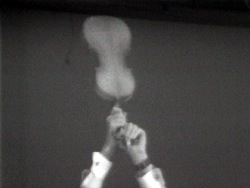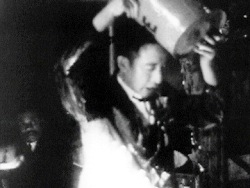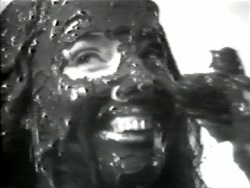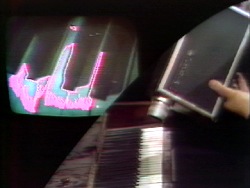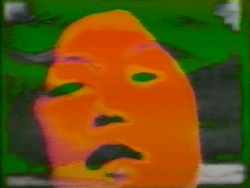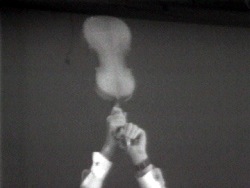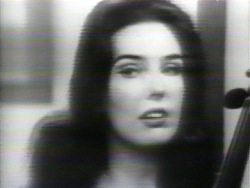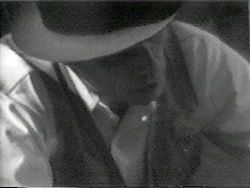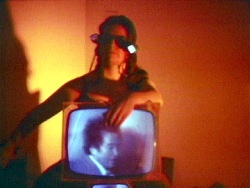Artists
Artists
Fluxus and Happenings
The influential international art group Fluxus began creating events, Happenings, and performances in the early 1960s in Europe, Japan and the U.S. Among the remarkable array of artists, musicians, writers and performers identified with Fluxus are Joseph Beuys, Yoko Ono, and Nam June Paik. Named by George Maciunas, the group's founder and principle advocate, Fluxus was characterized by its anarchy, humor and playfulness, and its desire to deflate art institutions and de-emphasize authorship. This selection includes documentaries on the Fluxus movement, documents of Fluxus events, and works by and about Fluxus artists.
Titles
A Portrait of a Friend by Friends: Emmett Williams
Joan Logue in collaboration with the artists.
1988, 23 min, color, sound
In this collaborative "verbal drawing," Fluxus artist, painter and poet Emmett Williams is profiled by his friends and colleagues. Fifteen artists, poets and writers convened in the Form Hotel in Warsaw, Poland to pay tribute to Williams in the form of personal anecdotes.
Theo Eshetu records a 1989 Fluxus event in Paris. Shooting with handheld video, Eshetu captures performances by Charlotte Moorman and Yoko Ono, among others. While sometimes wandering into abstraction, the up-close video technique allows a unique, fly-on-the-wall glimpse of a rare Fluxus performance event.
In 1979, The Kitchen hosted a concert of reconstructed historical Fluxus performances. Over forty short pieces by thirty artists and composers were performed. Among the works featured were those by renown Fluxus artists Yoko Ono, Ben Vautier, La Monte Young and George Maciunus. Performers included Simone Forti, Dick Higgins, Yoshi Wada and Geoff Hendricks. The program includes One for Violin Solo, first performed by Nam June Paik in 1962, and Incidental Music part 2, written by George Brecht in 1961.
Fluxfilm Anthology
Nam June Paik, Dick Higgins, Mieko (Chieko) Shiomi, John Cavanaugh, James Riddle, George Brecht, Robert Watts, Yoko Ono, Pieter Vanderbeck, Joe Jones, Erik Andersen, George Maciunas, Jeff Perkins, Wolf Vostell, Albert Fine, George Landow, Paul Sharits, John Cale, Peter Kennedy, Mike Parr, and Ben Vautier
1962-1970, 120 min, b&w and color, sound
Dating from the sixties and compiled by George Maciunas (1931-1978, founder of Fluxus), Fluxfilm Anthology is a document consisting of 37 short films ranging from 10 seconds to 10 minutes in length. These films (some of which were meant to be screened as continuous loops) were shown as part of the events and happenings of the New York avant-garde. Made by the artists ranging from Nam June Paik and Wolf Vostell to Yoko Ono, they celebrate the ephemeral humor of the Fluxus movement.
George Maciunas With Two Eyes 1972, George Maciunas With One Eye 1976
Shigeko Kubota
1994, 7 min, b&w, sound
In this rare portrait of Fluxus founder George Maciunas, Kubota pays homage to a mentor and fellow Fluxus artist. Maciunas tours SoHo with artists and friends, including Nam June Paik, Barbara and Peter Moore, and Yoshi Wada; Kubota also documents Fluxus artist Ben Vautier's 1976 opening at the Guggenheim Museum in New York.
This rare interview with Maciunas, the founder of Fluxus, took place a few months before his death in 1978. Maciunas discusses his "Diagram of Historical Development of Fluxus and other Four Dimensional, Aural, Optic, Olfactory, Epithelial, and Tactile Art Forms," tracing influences ranging from John Cage and Marcel Duchamp to vaudeville and Spike Jones.
Some Fluxus features performances from Miller's extensive archive, including works by Ay-O, Eric Anderson, George Brecht, Philip Corner, Jean Dupuy, Ken Friedman, Al Hansen, Geoffrey Hendricks, Dick Higgins, Joe Jones, Milan Knizak, Alison Knowles, Larry Miller, Takako Saito, Mieko Shiomi, Yasunao Tone, Yoshi Wada, Ben Vautier, and Robert Watts. Excerpts from Miller's 1978 Interview with George Maciunas provide historical context.
Some Manipulations depicts a series of 1969 performances at the Judson Church by Fluxus artists Jean Toche, Steve Young, Nam June Paik, and Al Hansen. Yalkut creates a staccato mix of color, motion and shape.
Stockhausen's Originale: Doubletakes
Peter Moore
1964-94, 30:05 min, b&w, sound, 16 mm film on video
This fascinating film documents the U.S. premiere production of Originale, a Happening by German composer Karlheinz Stockhausen. Filmed at the "2nd Annual Avant Garde Festival of New York," which was produced by Norman Seaman and Charlotte Moorman, the stage production was directed by Allan Kaprow. Performers include Nam June Paik, Moorman, Jackson Mac Low and Allen Ginsberg, among many others.
Yalkut documents the "chocolating" of Charlotte Moorman at the Clocktower in New York City on Easter Sunday, 1973. This project was based on a concept by artist Jim McWilliams, who devised other performance events for Moorman, including the Flying Cello.
This unconventional video portrait of the Fluxus movement, produced largely in Venice at a 1990 reunion, includes interviews with leading Fluxus artists, documentation of their works, and historic archival footage from thirty years of groundbreaking performances, films, and video tapes.
This historical document locates Nam June Paik's artistic origins as a composer, tracing his studies at the Conservatory for Music in Freiburg, his work with Karlheinz Stockhausen in Cologne, and the influence of the art and ideas of John Cage on his work. Also featured is documentation of the premier presentation of the TV Bra with Charlotte Moorman.
Artists
One of the most celebrated and iconoclastic figures of the American musical avant-garde, John Cage has been instrumental in reshaping postwar Western music. Cage's radical innovations in compositions and theory — the application of chance and "found" sound as an integral compositional device, the creation of musical structures based on rhythm rather than tonality — were influential in altering traditional concepts of musical interpretation.
Shigeko Kubota brought a singular sensibility to her extensive body of video sculptures, multi-media installations, and single-channel videos. Over her five-decade career, Kubota forged a lyrical confluence of the personal and the technological, often merging vibrant electronic processing techniques with images of nature, culture, art and everyday life. A prominent Fluxus artist in the 1960s, she also created an idiosyncratic video diary that spanned the 1970s to the mid-2000s.
Closely associated with the Fluxus movement, Larry Miller has produced a diverse body of experimental art works. Miller was a key figure in the emergent installation and performance movements in New York in the 1970s, presenting work in spaces such as 112 Greene Street Gallery, Franklin Furnace, PS 1, and the Kitchen. His installations and performances have been groundbreaking in their integration of diverse mediums and materials.
Described by composer Edgar Varese as "the Jeanne d'Arc of new music," Charlotte Moorman was a central figure of the New York avant garde of the 1960s and '70s. In 1963 she established the Annual Avant Garde Festival in New York, which she directed for two decades. As a performer, she was a longtime collaborator of Nam June Paik, who created many of his best-known pieces for her, including TV Bra for Living Sculpture (1969) and TV-Cello(1971).
Korean-born artist Nam June Paik was a seminal figure in video art. His video sculptures, installations, performances and single-channel videos encompassed one of the most influential bodies of work in electronic media art. Merging global communications theories with an irreverent Fluxus sensibility, his work in music, performance and video explored the juncture of art, technology, and popular culture. Paik, who is recognized as a visionary artist of the international avant-garde, died in 2006.
Willoughby Sharp, a founder and publisher of the seminal art magazine Avalanche (1970-76), is an artist, author, curator and teacher. Over the past four decades he has produced films, video sculptures, installations, broadcast works, transmission art, video performances and "Videoviews" (dialogues with contemporary artists), and was a pioneer of pre-Internet satellite art projects.
Jud Yalkut (1938-2013) was a pioneering intermedia artist and filmmaker. His remarkable body of moving image work, which spanned fifty years, ranged from early performance renderings and poetic filmic experiments to a series of groundbreaking hybrid video-film collaborations with Nam June Paik. Transcending and transforming media as he explored and merged film, video, expanded cinema, electronic manipulations, performance and installation, he created and collaborated on seminal intermedia projects with numerous artists, filmmakers, musicians and performers. Yalkut was also active as a teacher, curator and writer; his 350-page manuscript Electronic Zen is an essential cultural history of the nascent alternative video scene.


